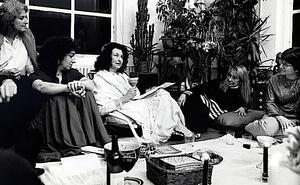Birth of Esther Broner, co-creator of "The Women’s Haggadah"
If one wanted to celebrate Esther Broner’s birth on this day, Broner herself would be the ideal person to create a new ritual for it.
The roots of the interests that would envelop her life are present, complete and whole, in her second novel A Weave of Women, published in 1978. The book centers on fifteen women from around the world who are living communally in Jerusalem in the early 1970s:
Each of the women is saddled to a different horse, reined to another life: Terry to action; Gerda to molecules and numbers, exactness and abstraction; Gloria to self-glorification; Dee to deaths and resurrections; Antoinette and Joan to the word; Dahlia to the note; Mickey to passion and regret; Hepzibah to the soul; Vered to responsibility; Tova to performance; among the wayward girls, Rina and Shula to respectability and Robin to confusion.
The book continues on in a dreamlike milieu with musical language and in a nonlinear style. Because received tradition has failed them, the women create new spiritual rituals — for birth, death, healing and exorcising demons, among other things, creating a new therapy, a new religion, out of scraps of Shakespeare and the Psalms.
Reviewing A Weave of Women in the New York Times, John Leonard called it “an astonishment,” adding: “E. M. Broner seeks nothing less than to achieve, in a kind of epic poem, a recapitulation of the rhythms of female consciousness…Its rhythm, its heartbeat, is renewal.”
Broner’s most enduring accomplishment was the creation with Naomi Nimrod of The Women’s Haggadah and an annual feminist Seder. From its origins as a personal dinner with friends, this retelling of the traditional Seder stories has since grown into a joyous, international celebration of triumph over enslavement leading to group liberation. As Letty Cottin Pogrebin recalled, “She made room for us at the table by creating a whole new one—a Seder table at which women’s voices were heard.” By creating new rituals, Broner empowered women to include themselves in Jewish religious life in ways they had not previously experienced.
Broner wrote new songs for each Seder, including this one:
This holiday we take for ourselves,
no longer silent servers behind the curtain,
but singers of the Seder,
with voices of gladness,
creating our own convocation,
and leaving “The Narrow Place” together.
Pogrebin noted the welcoming spirit of Broner’s work: “Esther Broner coaxed all these women out of their silence, and in so doing, she empowered our generation.”
Sources: “July 8: E.M. Broner,” Jewish Currents; “Esther Broner, Activist, Author, Mother of the Women’s Seder, Is Dead at 83,” The Jewish Daily Forward, June 23, 2011; “E.M. Broner, Jewish Feminist, Dies at 83,” New York Times, June 22, 2011.



